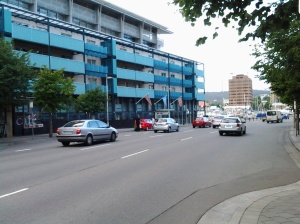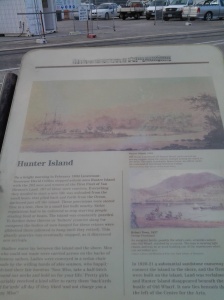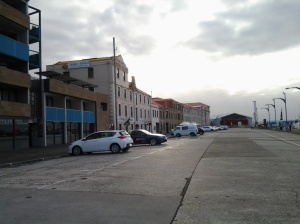The last leg of this Stage was the most interesting because I made discoveries which delighted me deeply.
At 12.18pm, I left my Channel Highway resting spot and walked downhill toward the people-free Taroona High School (closed for school holidays). Close to the bottom of the hill I could see the tops of boathouses and a ‘beach’ to my right so I took a dogleg to Melinga Place on my right and continued downhill.

I didn’t know this existed. Mostly a rocky shore, a little sand, edged by a mown green lawn. Serene. Across the Derwent River, I could see Gellibrand Point at the north of the South Arm peninsula.

Walking southwards it wasn’t long before I entered the foreshore bushland on an easy-to-walk dirt track.


Later I found this had a name: the Taroona Foreshore Track. At one point the ‘track’ passed over a ‘beach’ of shells and rocks then returned to dirt and rose up over areas raised above the water.


An onshore breeze kept me moving. Every so often, steep trails descended to the rocky shore but I realised that staying on the track would be more comfortable than rock hopping the edge of the River.
When I walked through a grove of trees that were obviously different, I was delighted to read an information panel which informed me this was an “unusual and isolated stand of blackwoods. Acacia melanoxylon.” The species is also known as Sally wattle, lightwood, hickory, mudgerabah, Tasmanian blackwood or black wattle. Their rough bark seemed as if it would flake off in small pieces but it was toughly attached.


At 12.46pm I looked back northward and could still see the boathouses near the High School.

A couple of minutes later I reached Crayfish Point where I noticed craypot markers bobbing in the Derwent River as evidence that fishing for crayfish/lobster was taking place. However, a sign seemed to indicate this was part of fisheries research by the University of Tasmania.

Brilliant orange lichen sprawled across some of the rocks. Huge Pied Cormorants rested on rocks with water lapping at their feet. This was one of those brilliant days when all the superlatives in the world seem inadequate.
It was near here that an information panel enlightened me about some of the native vegetation. Now I can identify not only Pigface which I love, but also Bower Spinach and Grey Saltbush. Why I didn’t take photos of the real thing while I was walking I cannot say. Daft! So I have Googled for images: If you type in Bower Spinach Tasmania Images, up comes a suite of pictures showing this fleshy leaved plant. Try something similar to find images of the softly grey coloured Grey Saltbush.
When I reached the start of Taroona Beach at 12.53pm, I looked up the hill and in the distance I could see the Shot Tower that had been built in 1870 (the Shot Tower, a major tourist attraction, is normally accessible from the Channel Highway).
The Batchelor’s Grave Historic Site, just above the foreshore of Taroona Beach, was a surprise. Wikipedia provides the information that this is “the grave of a young sailor, Joseph Batchelor, who died on the sailing ship Venus in the Derwent Estuary in 1810, and was buried ashore on 28 January 1810. It is reputed to be the oldest European grave in Tasmania”. I am amazed at this idea. I cannot imagine that many Europeans didn’t die and were buried in Van Diemens Land before 1810 – however, maybe this is the only stone grave marker left from early in the 19th century.


Taroona Beach is backed by Taroona Park with pleasant picnicking facilities and public toilets.


I left at 1.06pm and walked along Niree Parade for a couple of minutes until the Taroona Foreshore Track restarted.
Within moments I arrived at Hinsby Beach, which was the find of the day as far as I am concerned. Isolated. Small. Tree edged. Calm. Small wave break. A few boathouses. A family beach with a few swimmers and sun bathers. Located at the end of the River edge before the steep Alum Cliffs which flow for 3 or four kilometres to Kingston.


I soaked in the atmosphere before starting uphill on a public access walkway at 1.22pm, under shady bushes with lush surrounding ground cover. The track connected to the bottom of Hinsby Road. At the top of Hinsby Road the Channel Highway flowed by. As I arrived at bus stop 30 at 1.36pm, a Metro bus came by on which I made the trip back into Hobart. Half an hour later I was in the city and ready to make the bus trip back home in Bellerive. I walked in the door at 2.40pm after an exhilarating day when my feet didn’t want to carry me, but I insisted and they persisted. This really is a wonderful part of the world.
-42.953850
147.346129





























